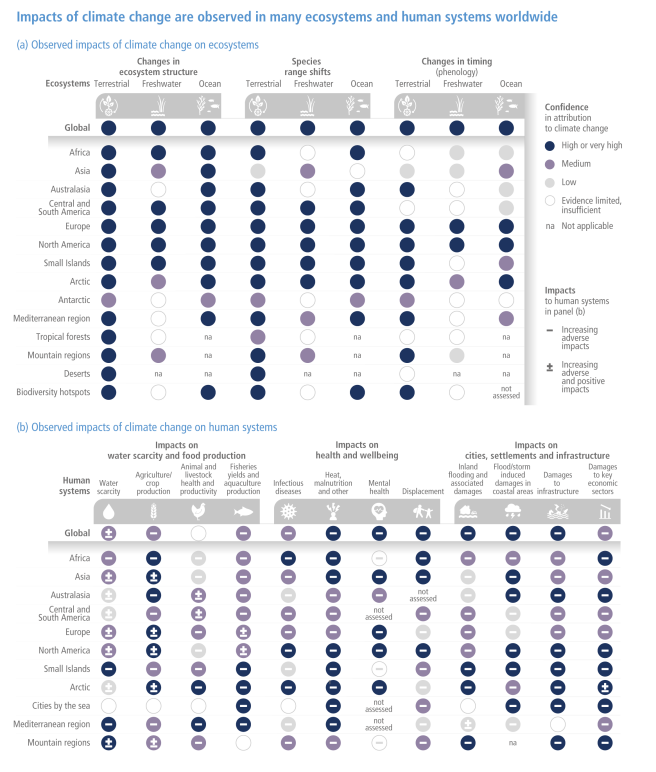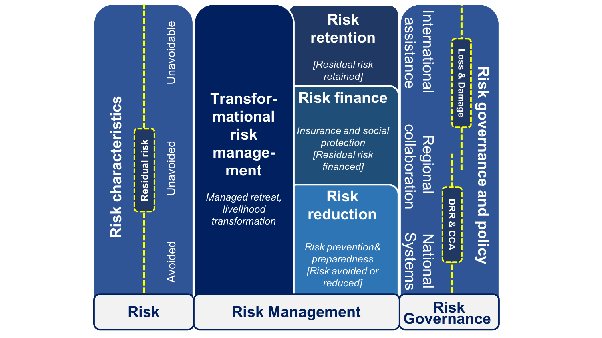Earlier this week the IPCC Working Group II report Climate Change: Impacts, Adaptation, and Vulnerability was released. The message is unequivocal: climate change is a threat to human wellbeing and the health of the planet. The poorest people in climate vulnerable regions are most at risk. Urgent climate action and transformation will be necessary to close growing gaps with regard to adaptation, coverage of losses and damages and mitigation.
Observed losses and damages: dangerous and widespread disruption today
The latest IPCC report in its Summary for Policymakers, the Technical Summary and the underlying chapters shows that global warming of 1.1°C has already caused dangerous and widespread losses and damages, led to disruptions in nature and affected the lives of billions of people – despite efforts to adapt. Research has increasingly attributed these impacts to man-made climate change. This is true across regions, systems and sectors (see figure).

Impacts identified are massive: Roughly half the world’s population currently experiences severe water scarcity at some point each year, with climate change a key driver of this. Increased warming, heatwaves and droughts are hindering efforts to achieve the UN goals of ‘zero hunger’ and ‘water for all’. 3.3-3.6 billion people across West-, Central- and East Africa, South Asia, Central and South America, Small Islands Developing States and the Arctic are considered highly vulnerable to climate change.
Future risks on a warming planet
Beyond 2040 and depending on the degree of warming, climate change is projected to result in impacts multiple times higher than what we’re currently seeing. Every small increase in warming beyond 1.5°C will result in increased risk of severe impacts as shown in the graph below.
This most recent IPCC assessment shows that less warming than previously thought is likely to result in high or very high risks of impacts such as extreme weather events. And: some risks will be irreversible and existential. This makes the case for reducing greenhouse gases to meet the 1.5°C target agreed in Paris in 2015 even stronger.

Those hardest hit by climate change impacts are, and will be, people in regions experiencing the highest temperatures, those living along coastlines, in the frozen parts of the world, along rivers, and where other threats exist. Sea level rise will put people living in coastal areas at greater flood risk and low-lying coastal ecosystems, such as mangroves, will be submerged and lost, the latter an effect also of increased marine heatwaves.
Climate Change adaptation and risk management
While reducing greenhouse gas emissions to limit global warming to 1.5C would substantially reduce climate-related losses, they cannot be eliminated completely. Adaptation and risk management is needed to further address climate-related risks, which are also driven by factors associated with vulnerability and exposure of people and nature.
In terms of good news, the report shows that adaptation and risk management are proceeding all over. The big caveat is that adaptation effectiveness decreases with warming and adaptation gaps are being observed
Growing public and political awareness of climate impacts and risks has resulted in at least 170 countries including adaptation in their climate policies and many cities are integrating climate change into their planning processes. This is good news.
Investments in adaptation are expected to reduce risks and damages as well as generate multiple benefits including improved productivity, innovation, health and wellbeing, food security, livelihoods, and biodiversity conservation.
However, there is further bad news as well. Adaptation progress is unevenly distributed and underfunded. Previous research by the Zurich Flood Resilience Alliance shows that not enough climate finance is invested in adaptation, and that investments are not targeting those who need it most.
The IPCC report also suggests that many adaptation efforts are fragmented, small in scale, sector-specific, designed to respond to current impacts and near-term risks, focused on planning rather than implementation and dominated by incremental and reactive responses.
There is clear insight into the need for considering how transformation can complement incremental adaptation to led to profound and systemic change. Yet further evidence at scale will be needed, such as is being produced by the Zurich Flood Resilience Alliance.
The limits of Adaptation and the role of Loss & Damage
It is important to note that even with effective adaptation we cannot prevent all losses and damages. Many natural and human systems are near their adaptation limits and additional limits will emerge with increasing global warming.
In addition to gaps and limits linked to adaptation, the report also focusses on the need for dealing with impacts and residual risks ‘beyond adaptation.’
Losses and damages are unequally distributed. Despite increased attention to Loss and Damage at COP26, financial, governance and institutional arrangements from local to national to international are falling short. Adaptation gaps coupled with gaps in social protection and insurance mean that there are disproportionate burdens on low-income households and communities which may increase and perpetuate poverty.
As assessed in Chapter 17 through a Cross-Chapter box on Loss&Damage (17.2), international attention to, what may be called the protection gap (yet not discussed in the IPCC report under this term), through Loss&Damage policy dialogue is seeing ample attention also in research, but negotiators have not been able to agree on a policy space thus impeding further action. The chart shows how Loss&Damage may address the protection gap with regard to unavoided losses and damages while complementing action on disaster risk reduction (DRR) and adaptation (CCA) to avoid (and reduce) losses and damages now and in the future.

Urgency to tackle climate change is increasing while window of opportunity closes
The overall takeaway of the IPCC summary and the science presented across the many underlying chapters of the report is that urgent action is necessary for closing gaps with regard to mitigation, adaptation and Loss and Damage.
Allowing further delay in concerted global action will mean missing a brief and rapidly closing window to secure a liveable future for all, particularly those most vulnerable to the effects of climate change, like the communities supported by the Zurich Flood Resilience Alliance.
If you want to hear me and fellow IPCC lead author Erin Coughlan de Perez translate the science further and my colleagues from Nepal and Bangladesh share their experience of working on climate change adaptation with communities affected by floods and other climate hazards join our webinar later today, Thursday 3 March. Find out more and register now.

Comments